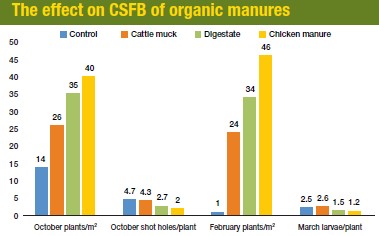Overcoming cabbage stem flea beetle comes down to identifying the right pieces of the chemical and cultural control jigsaw and putting them in place. CPM summarises some of the latest research.
You can beat the beetle, and you can do so very economically too.
By Rob Jones
There are striking similarities between blackgrass and cabbage stem flea beetle – an over-reliance on chemical means of control has been said to lie at the heart of why both became such challenging issues for growers. Just like blackgrass, all the research points to a jigsaw of cultural and chemical controls as the best way to beat CSFB.
In exactly the same way too, these controls are best applied alongside one another with careful planning, stresses Agrii trials manager, Steve Corbett. It should be firmly based on the degree of field risk; starts with the rotation; and, has sufficient flexibility to cater for different conditions – especially soil moisture.
“Insufficient moisture or excessive pest pressure at establishment means we are likely to be fighting a losing battle whatever we do,” he says.

Insufficient moisture at establishment makes it likely a crop will be fighting a losing battle says Steve Corbett.
“The starting point is a rotation wide enough to restrict the build-up of local pressure. And, we shouldn’t even consider sowing OSR unless and until we have sufficient moisture in the ground.
“The right entry for OSR also helps, mainly because all our work over the past 11 years highlights the importance of presenting a barrier to the beetle that minimises the ‘green on brown’ attractiveness of the young OSR crop,” he adds.
Field-scale Agrii trials at Chiseldon in Wilts last season, indeed, showed average shot-holing damage in a crop grown on bare ground was twice that on ground with a good covering of winter barley debris.
At Langley in Essex in 2018, there was a more than threefold difference in leaf damage between a young crop in bare soil and one with decent straw and chaff coverage.
Equally, the difference in damage between a crop sown into high (300mm) and low (75mm) stubbles was almost as substantial at the AgriiFocus technology centre.
Where a preceding fallow, spring barley or baled straw crop offers little, if any, decent cover, Steve suggests a nurse or companion crop could offer a valuable alternative CSFB barrier.
As nurse crops, buckwheat and, to a lesser extent, fenugreek sown into reasonable moisture late last July noticeably reduced flea beetle damage in OSR sown three weeks later in his trials at Saxby Cliffe in Lincs.
In contrast, at Throws Farm in Essex buckwheat nurse crops sown into much drier soils resulted in poor establishment and relatively high levels of damage to OSR sowings two weeks later. Drilled with the OSR as a companion crop, though, buckwheat did a much better job, keeping average CSFB damage down to 3.5% against 24% in the nurse crop plots.
“In other trials, we’ve seen a buckwheat companion crop do as well in reducing shot-holing as some promising new seed treatments,” points out Steve. “However, lack of moisture in this study meant it couldn’t get away as a nurse crop, providing far too little cover. In contrast, the companion crop plots were sown into more moisture.
“Having said that, we’ve also found nurse crops can grow far too well, shielding the OSR planted into them but, at the same time, compromising their establishment. And we’ve seen companion crops be a waste of time and effort when they haven’t had enough moisture.”
So, like the crop itself, sufficient moisture is the critical factor. Equally important with companion cropping is using the right variety of buckwheat in particular at the right rate and sowing it at the right depth, the Agrii work has shown.
The two varieties the R&D team have been studying are very different. Common buckwheat is spindly and runs to flower too rapidly to give a decently sustained cover, while the alternative establishes a much better canopy and gives more extended protection. At the same time, the size and shape of common buckwheat seeds means they separate out more from the OSR in single hopper drills, leading to less even crop cover.
“It’s a jigsaw of agronomic support we need,” Steve insists. “This includes minimal soil disturbance at drilling, fast-developing varieties, good seedbed nutrition and timely early insecticide spraying as well as long stubbles, good soil cover and/or effective nurse or companion cropping.”
While putting it all together is by no means easy, Agrii regional technical adviser, David Felce who farms at St Neots has no doubt about the value it offers.
“A good seedbed with sufficient moisture is crucial,” he agrees. “Spreading slurry or digestate can really help get the crop away. And fast-developing varieties are important too. We have, however, found no value in increasing seed rates. This only leads to thinner-stemmed crops less able both to tolerate larvae and to branch away from them in the spring.
“Our trials show the value of protected phosphate together with a balance of nitrate and ammonia N and immediately available boron in the seedbed as a specialist starter fertiliser. They also underline the contribution lamba-cyhalothrin can make when used at the best time – crop emergence.”
As proof of the pudding, Agrii head of agronomy Colin Lloyd points to the latest Throws Farm trials with one of the fastest-developing OSR varieties available (DK Expedient) sown at two seed rates with 12 different establishment programmes and three sets of drilling conditions.
Averaged across cultivation methods and seed rates, the recorded damage levels clearly demonstrate the value of stacking the controls in exactly the same way as blackgrass management.
As the package builds from a relatively poor nurse crop treatment alone at one end of the scale to a decent companion crop plus specialist starter fertiliser and early pyrethroid spray programme at the other, so flea beetle damage in a challenging season declines from an average of almost 25% to virtually zero.
“This says it all,” he concludes. “Unless you are faced with too little moisture or your recent crop experience suggests the pest pressure is likely to be too high – in which case it may be unwise to sow OSR – you can beat the beetle, and you can do so very economically too. But only if you are willing and able to put the right pieces of the cultural control jigsaw together for your own conditions.”
Pioneering Agrovista trials in the early days of the neonicotinoid ban showed a reduction in flea beetle larval burdens from berseem clover as a companion plant. And more recently the company has seen good results from combining companion cropping with other elements of OSR agronomy.
Overall, technical manager, Mark Hemmant sees the primary benefit of companion cropping coming from the extra help it gives OSR to grow away from CFSB.
“Our original studies focussed on capturing nitrogen and improving soil condition,” he says. “These continue to be vital considerations today. But the real value we have found from companion crops is in improving OSR establishment.
“While berseem clover’s top growth is relatively restricted – so it doesn’t compete with the crop – strong tap roots really open-up heavy soils, in particular, making them far more friable and much better drained – which OSR appreciates massively.
“Using just 2.5-3kg/ha of seed costing £10/ha or less, we’ve seen marked improvements in OSR root development, root diameter and establishment rates. As well as enabling the crop to survive reasonable levels of adult flea beetle pressure, this ensures it is big and strong enough to tolerate the larvae.”
Mark insists that companion cropping is only one weapon in the establishment improvement armoury and urges growers to use the most effective cultural controls for their particular circumstances.
To preserve moisture at drilling while achieving the best seed-to-soil contact, he advocates seeders that move trash out of the way, cultivate within the slot and disturb the least amount of soil on the surface in preference to simple direct drills.
His trials with longer stubbles have shown useful reductions in flea beetle damage by producing a better micro-climate for the OSR, although their value has varied between seasons. The work has also pointed up the need for drills that can cope with such stubbles and still sow evenly and close the slot consistently.
“Having battled devastating cabbage root fly in crops near gardens growing brassicas, I wouldn’t sow OSR before mid-Aug unless conditions are near perfect,” advises Mark. “Especially not, as the earlier you sow the more flea beetle larvae you get.
“I consider varieties that develop fast in the autumn and spring essential these days, regardless of drilling date. The imperative is to get the crop away, and most growers I know would be more than happy to have a crop needing positive growth regulation.
“Clearfield varieties may have a useful edge for their ability to tolerate residues and the fact that they allow broadleaf herbicides which can also hold the crop back to be delayed,” he adds. “Because we can’t really control flea beetle, doing everything we can to help the crop tolerate both adults and larvae has to be our priority,” concludes Mark.
Smelly muck wards off beetles, suggests new study
Organic manuring ahead of drilling can noticeably reduce damage from both cabbage stem flea beetle adults and larvae as well as improving crop establishment, according to the latest Royal Agricultural University study. But its value very much depends on the type of manure.
The current season study by undergraduate student, Ted Allen-Stevens with Dr Nicola Cannon shows well rotted chicken manure delivering better results than either digestate or cattle muck across 1ha direct-drilled plots in an early Sept-sown Glos crop.
“The warm, dry weather in mid-Sept really impeded crop establishment and heightened flea beetle activity,” reports Ted. “Thankfully, a combination of two pyrethroid sprays and cooler, wetter conditions from the last week of the month turned the tables in the crop’s favour, allowing all but the control plot to establish satisfactorily.
“The extra pressure of the wet winter led the control plot to fail completely, while the manured plots came into the spring with average populations of between 24 and 48 plants/m².
“Cattle muck was the least successful of our treatments,” he explains. “Even so, the 20t/ha we surface applied the day before drilling – supplying 8.5kgN/ha – led to higher average Oct and Feb plant counts than the control. Similar levels of shot-holing/plant in the autumn and larvae/plant in the late spring suggests its value here was entirely nutritive.”

Source: Ted Allen-Stevens, Fairford organic manuring trial; Royal Agricultural University, 2020.
Unsurprisingly, given the higher levels of N supplied, 20m³/ha of digestate and 9t/ha of chicken manure both markedly improved autumn and spring plant populations. They also resulted in less shot-holing and fewer larvae/plant.
Very surprising, though, were the noticeably higher autumn and spring plant populations and lower levels of adult and larval damage with the chicken manure which supplied just 13.1kgN/ha compared to the digestate supplying 62.2kgN/ha.
“Despite containing only around a fifth of the nitrogen and in a less readily available form than the digestate, the chicken manure came out on top in every respect, with the possible exception of very early plant counts,” points out Ted.
“Both these treatments appear to have had a deterrent effect on adult beetle feeding, masking the isothiocyanate exudates from the crop known to attract them, perhaps; an effect that would naturally feed through to lower larval burdens.
“Chicken manure was the stand-out here. Like the digestate, it gave more even ground cover than the cattle muck. It also had a much stronger effluent effect (odour) on application.”
Battling the beetle
In this series of articles, Bayer is working with CPM to share the widest possible experience of leading researchers and advisers in combatting the upsurge in CSFB that is causing such a challenge for so many growers across the country.
For Bayer, this is part of its Dekalb seed brand’s role in providing trusted support to OSR growers and their agronomists that goes well beyond the most robust and dependable varieties that have always been its trademark.
We very much hope growers will find this series valuable in identifying current and future OSR management opportunities they can put to effective use in minimising the threat CSFB presents and securing the most reliable returns from this vital component of modern combinable crop rotations.




